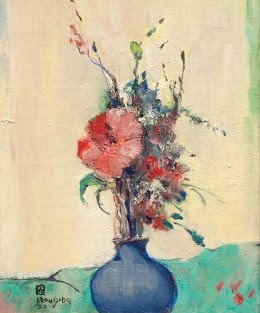When Leon Dabo was an aspiring artist in Paris Japomisme had taken the city by storm. Paintings, ceramic, posters, showed the French infatuation with all things Japanese.
Artful arrangements were a specialty of Dabo's floral paintings. You can see the influence of ikebana (the Japanese art of flower arranging in The Blue Vase. The origins of Ikebana date back at least a millennium. Wabi sabi is an aesthetic that finds beauty in transience and imperfection..
Feathery strokes are all he needed to suggest the evanescent life of flowers. A simple wash technique sufficed for the cobalt blue vase and its soft pink backdrop. Asymmetry is also present in the indeterminate turquoise plane the vase sits on. This painting is an affectionate tribute to Japonisme.
Flower painting has long been the province of romantic painters; there just is something about their loveliness that inspires sentiment. Dabo's interest in flower painting may have been stimulated when he worked under John La Farge in New York during the 1890s.. Like La Farge, Dabo worked in several media.
The vases are usually simple providing the pretext for floral flights of fancy. The background only hints at a setting; the lightly outlined turquoise contrasts pleasingly with the cobalt blue vase but barely delineates its location.
It came as a surprise to critics in 1933 when an exhibition of Dabos' floral paintings went on view at the Knoedler Gallery in Manhattan. He had been keeping them private, some of them for two decades. Who might we compare Dabo to? Perhaps he is "the Manet of flowers."
Flower painting dates back to the days of the ancient Egyptian pharaohs who used the lotus to symbolize the all-powerful sun. The figures in Medieval French tapestries, notably the Bayeux Tapestries, portray humans and animals against a background of cascading flowers; these too had specific meanings. Renaissance artists were inspired by these millefleur tapestries; for the first time flowers themselves became the subject. The century from 1750-1850 was the golden age of botanical illustration.
Image: Leon Dabo - The Blue Vase, 1952, oil on canvas, Sullivan Goss Gallery, Santa Barbara.


2 comments:
Thank you for that nice description, Jane. I like the formula "the Manet of flowers" for this painting "ikebana" which shows so well at the same time the grace of the flower and its fragility.
Tania, yes. I have had the book "The Last Flowers of Manet" for years.
I took a course in Ikebana a few years ago and loved the simplicity of the arrangements.
Post a Comment